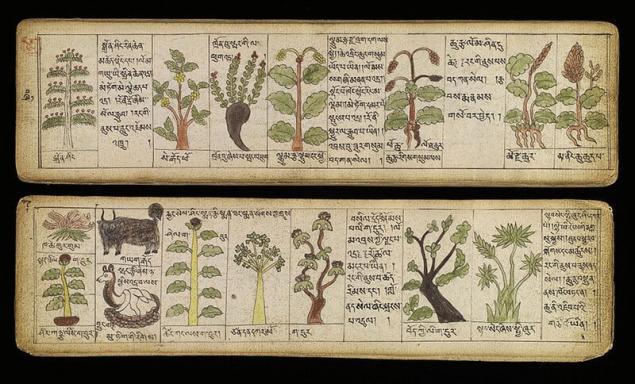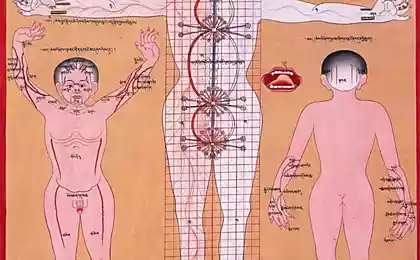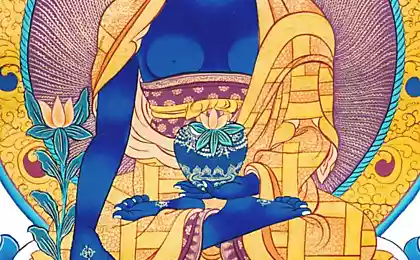531
The origins and topics of Tibetan medicine
For a long time of its existence, Tibetan medicine has experienced periods of prosperity and decline. During the religious feuds, and for the last fifty years, lost many texts, however, in periods of prosperity in a large number of new. In this constant balancing Knowledge OWL RIGPA still exists.
Geshe Rinchen Tenzin

Now Tibetan medicine is associated with Tibet, however, it arose in the ancient Kingdom of Shang Shung, which were about 6-7 thousand years ago. According to legend, its center was located in the area of mount Kailas (in the modern Central Tibet). Nowadays these lands are located in various countries and regions: Iran, Pakistan, Tajikistan, Kashmir, Ladakh etc. of Shang Shung was a great Kingdom, a large part of modern Tibet also belonged to him. Scientists say that the Kingdom disintegrated into several States, ceased to exist about 2 thousand years ago
In countries such as Iran or Tajikistan, for example, even before the arrival of the Muslims was spread an ancient tradition of belief that is associated with Zhang Zhung. The correlation of ancient paganism with religious beliefs of the ancient Shang Shung. For example, the ancient peoples who inhabited the territory of modern Russia, there are images of the swastika is a solar symbol similar were they and equipment prayers. I'm certainly not saying that all of Russia or part of it belonged to the Kingdom, says the teacher, but there is a deep relationship between them, which can be detected. These traces of the ancient culture of Zhang-zhung, there are still other territories in Tajikistan, for example. In Muslim countries there is a traditional medical science which is still used, however, it did not arise in the Muslim period, and appeared earlier.
Source of Tibetan medicine is the sacred text "Boom Shi". In accordance with the Bon tradition it is believed that the traditional medical science originated about 10 thousand years ago. However, one can surely say is that she really has existed for about 4 million years ago, according to some researchers of the issue.
There are people who say that until the X-XI centuries ad, the Tibetan medicine did not exist, that it is borrowed from India and China, but it is not. We believe that the oldest medicine on Earth is most fully preserved in the Tibetan tradition. This science did not create some people, it arose gradually with the development of society. People began to observe his diet, to note which food can hurt the stomach, and that has a therapeutic effect. For example, if you drink water, it helps with many digestive problems. From such observations was created and developed knowledge of, and use to this day. The great master of Bon Tonpa Shenrab asked his disciples to compose a text based on this knowledge and gave explanations of what and how do you want to write. First, as suggested by the Tibetans, collected, compiled and recorded these instructions Chebu Trichet: son of Tonpa Shenrab. The first text of this ancient Knowledge was composed of about 4 thousand years ago. He later appeared in Tibetan and Sanskrit, and in Chinese.
In particular, it is important to give the explanation, which by today's official point of view, the author – compiler of "chzhud-Shi" is Utah yonten, Gonpo the younger (1126-1202), he is the descendant and incarnation of Utaga Iontana, Gonpo older, who lived in the 8th century and hid early medical texts for the next generations. Utagba Junior added and edited "chzhud Shi – Four tantras". This revised version remains unchanged in our time. With the text "Boom Shi", the main book of the Bon medical tradition, the differences a bit.
For a long time of its existence, Tibetan medicine has experienced periods of prosperity and decline. During the religious feuds, and for the last fifty years, lost many texts, however, in periods of prosperity in a large number of new. In this constant balancing Knowledge OWL RIGPA still exists.
In General, Tibetan medicine consists of three main sections. The first section is called "Nature or Basis" and includes knowledge about what is in the human body, how and what components it is formed. It also explains the nature of all living things, a structure, which can be considered the whole surrounding world: animals, plants, stones.
In the second section, "Diagnosis" discusses the elements that make up the body, in balance or unbalanced they are, can observe it and analyze. There are different methods of diagnosis: in particular, using a survey you can understand how a person eats, what kind of life, how it feels when you do this; as a pulse, the doctor makes a conclusion about what violations are present in the body. Also diagnosis is carried out with observation of the tongue, urine and overall appearance of a person, the colour of his skin, etc.
The third section – "Treatment" – is divided into two parts: methods of treatment of diseases methods of health preservation and longevity (a long life without disease). If the disease is already present, depending on its strength the doctor understands how you want to deal with it.
The healing occurs through four methods.
In the first place is food. If you just power adjustment does not help the recovery of patients, it is recommended to pay attention to follow exactly the prescribed way of life. If the combination of nutrition and lifestyle do not lead to a positive result, it is recommended that the third method is the adoption of drugs. If you do not help even drugs, then resort to the fourth method the different procedures, such as massage, moxibustion, bloodletting, surgery on the body and other external influences.
Perhaps, modern people believe that in ancient times it was impossible to conduct operations. In fact, different types of operations were described in ancient medical texts. Scientists recognize the fact that around 1600 years ago have been held to eye surgery and surgery help with the birth of a child. In ancient India, China and Tibet, technological progress was at a very low level, which is not true of culture, education and spiritual development of the people of that time. Even now, aspects of psychology and self-development in these countries manifest very strongly.
In General, it is clear that Tibetan medicine was created not by Tibetans as such: they adopted this knowledge from the ancient Kingdom of Shang Shung. Now medicine called Tibetan because Tibetans keep this tradition. In recent time thanks to the efforts of the Tibetan doctors of the Tibetan medicine was widely disseminated throughout the world. published
From the book: "Science of health"
P. S. And remember, only by changing their consumption — together we change the world! ©
Source: www.ustinova.info/istoki-tibetskoj-meditsiny/
Geshe Rinchen Tenzin

Now Tibetan medicine is associated with Tibet, however, it arose in the ancient Kingdom of Shang Shung, which were about 6-7 thousand years ago. According to legend, its center was located in the area of mount Kailas (in the modern Central Tibet). Nowadays these lands are located in various countries and regions: Iran, Pakistan, Tajikistan, Kashmir, Ladakh etc. of Shang Shung was a great Kingdom, a large part of modern Tibet also belonged to him. Scientists say that the Kingdom disintegrated into several States, ceased to exist about 2 thousand years ago
In countries such as Iran or Tajikistan, for example, even before the arrival of the Muslims was spread an ancient tradition of belief that is associated with Zhang Zhung. The correlation of ancient paganism with religious beliefs of the ancient Shang Shung. For example, the ancient peoples who inhabited the territory of modern Russia, there are images of the swastika is a solar symbol similar were they and equipment prayers. I'm certainly not saying that all of Russia or part of it belonged to the Kingdom, says the teacher, but there is a deep relationship between them, which can be detected. These traces of the ancient culture of Zhang-zhung, there are still other territories in Tajikistan, for example. In Muslim countries there is a traditional medical science which is still used, however, it did not arise in the Muslim period, and appeared earlier.
Source of Tibetan medicine is the sacred text "Boom Shi". In accordance with the Bon tradition it is believed that the traditional medical science originated about 10 thousand years ago. However, one can surely say is that she really has existed for about 4 million years ago, according to some researchers of the issue.
There are people who say that until the X-XI centuries ad, the Tibetan medicine did not exist, that it is borrowed from India and China, but it is not. We believe that the oldest medicine on Earth is most fully preserved in the Tibetan tradition. This science did not create some people, it arose gradually with the development of society. People began to observe his diet, to note which food can hurt the stomach, and that has a therapeutic effect. For example, if you drink water, it helps with many digestive problems. From such observations was created and developed knowledge of, and use to this day. The great master of Bon Tonpa Shenrab asked his disciples to compose a text based on this knowledge and gave explanations of what and how do you want to write. First, as suggested by the Tibetans, collected, compiled and recorded these instructions Chebu Trichet: son of Tonpa Shenrab. The first text of this ancient Knowledge was composed of about 4 thousand years ago. He later appeared in Tibetan and Sanskrit, and in Chinese.
In particular, it is important to give the explanation, which by today's official point of view, the author – compiler of "chzhud-Shi" is Utah yonten, Gonpo the younger (1126-1202), he is the descendant and incarnation of Utaga Iontana, Gonpo older, who lived in the 8th century and hid early medical texts for the next generations. Utagba Junior added and edited "chzhud Shi – Four tantras". This revised version remains unchanged in our time. With the text "Boom Shi", the main book of the Bon medical tradition, the differences a bit.
For a long time of its existence, Tibetan medicine has experienced periods of prosperity and decline. During the religious feuds, and for the last fifty years, lost many texts, however, in periods of prosperity in a large number of new. In this constant balancing Knowledge OWL RIGPA still exists.
In General, Tibetan medicine consists of three main sections. The first section is called "Nature or Basis" and includes knowledge about what is in the human body, how and what components it is formed. It also explains the nature of all living things, a structure, which can be considered the whole surrounding world: animals, plants, stones.
In the second section, "Diagnosis" discusses the elements that make up the body, in balance or unbalanced they are, can observe it and analyze. There are different methods of diagnosis: in particular, using a survey you can understand how a person eats, what kind of life, how it feels when you do this; as a pulse, the doctor makes a conclusion about what violations are present in the body. Also diagnosis is carried out with observation of the tongue, urine and overall appearance of a person, the colour of his skin, etc.
The third section – "Treatment" – is divided into two parts: methods of treatment of diseases methods of health preservation and longevity (a long life without disease). If the disease is already present, depending on its strength the doctor understands how you want to deal with it.
The healing occurs through four methods.
In the first place is food. If you just power adjustment does not help the recovery of patients, it is recommended to pay attention to follow exactly the prescribed way of life. If the combination of nutrition and lifestyle do not lead to a positive result, it is recommended that the third method is the adoption of drugs. If you do not help even drugs, then resort to the fourth method the different procedures, such as massage, moxibustion, bloodletting, surgery on the body and other external influences.
Perhaps, modern people believe that in ancient times it was impossible to conduct operations. In fact, different types of operations were described in ancient medical texts. Scientists recognize the fact that around 1600 years ago have been held to eye surgery and surgery help with the birth of a child. In ancient India, China and Tibet, technological progress was at a very low level, which is not true of culture, education and spiritual development of the people of that time. Even now, aspects of psychology and self-development in these countries manifest very strongly.
In General, it is clear that Tibetan medicine was created not by Tibetans as such: they adopted this knowledge from the ancient Kingdom of Shang Shung. Now medicine called Tibetan because Tibetans keep this tradition. In recent time thanks to the efforts of the Tibetan doctors of the Tibetan medicine was widely disseminated throughout the world. published
From the book: "Science of health"
P. S. And remember, only by changing their consumption — together we change the world! ©
Source: www.ustinova.info/istoki-tibetskoj-meditsiny/























